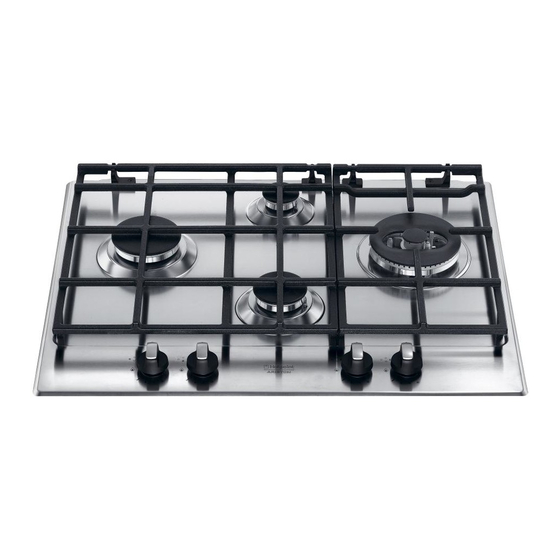- ページ 2
ホブ Ariston PK 640 R GH AUSのPDF 取扱説明書をオンラインで閲覧またはダウンロードできます。Ariston PK 640 R GH AUS 44 ページ。
Ariston PK 640 R GH AUS にも: 取扱説明書 (32 ページ)

Installation
! Before operating your new appliance please read this
AUS
instruction booklet carefully. It contains important
information for safe use, installation and care of the
appliance.
! Please keep these operating instructions for future
reference. Pass them on to possible new owners of the
appliance.
Compliance with standards
This cooktop must be installed by an authorised
person in accordance with the requirements of local
gas and electrical authorities, as well as the latest
published versions of the following standards:
• AS/NZS 5601 Gas Installations and pipe sizing
• SAA Wiring Rules.
Positioning
! Keep packaging material out of the reach of children. It
can become a choking or suffocation hazard ( see
Precautions and tips ).
! The appliance must be installed by a qualified and
authorised professional according to the instructions
provided. Incorrect installation may cause harm to people
and animals or may damage property.
Kitchen Ventilation
Where the total input of all appliances exceeds 3
MJ/h for each cubic metre of the room or enclosure
volume, the space shall be ventilated by one of the
methods detailed below. For the purpose of
assessing the adequacy of ventilation, the space
that cannot be isolated by doors is the 'volume of a
room'.
Natural ventilation direct from outside
Two permanent openings shall be provided directly
to outside. The openings shall be located to ensure
the distance between the top of the upper opening
and the ceiling of the room or enclosure, and the
distance between the bottom of the lower opening
and the floor of the room or enclosure does not
exceed 5% of the height of the room or enclosure.
The minimum free ventilation area provided by each
opening shall be calculated using the following
formula:
A = 3 × T
where
A = the minimum free ventilation area (cm
T = the total gas consumption of all appliances
(MJ/h)
The minimum vertical dimension of any free
ventilation opening shall be 6 mm.
2
NOTE 1 When used in this Clause, the term 'directly
to outside' means any one of the following options,
provided that the ventilation path is unobstructed by
building material or insulation:
(a) Directly through an outside wall (preferred
option).
(b) Through to an outside wall but offset.
(c) Into a cavity ventilated to outside.
(d) Into an under floor space ventilated to outside.
(e) Into a roof space ventilated to outside.
NOTE 2 The two openings may be combined
provided that the top and bottom of the opening
reach the limits set by this Clause.
Natural ventilation via adjacent room
Two permanent openings shall be provided in the
room or enclosure. The openings shall be located to
ensure the distance between the top of the upper
opening and the ceiling of the room or enclosure,
and the distance between the bottom of the lower
opening and the floor of the room or enclosure does
not exceed 5% of the height of the room or
enclosure.
The minimum free ventilation area provided by each
opening shall be calculated using the following
formula:
A = 6 × T
where
A = the minimum free ventilation area (cm
T = the total gas consumption of all appliances
(MJ/h)
These requirements shall apply to all subsequent
rooms until a room is ventilated to outside, in
accordance with the previous section, or the total
input of the appliances does not exceed 3 MJ/h for
each cubic metre of the total volume of the
enclosure and rooms.
The minimum vertical dimension of any free
ventilation opening shall be 6 mm.
NOTE: : : : : The two openings may be combined
provided that the top and bottom of the opening
reach the limits set by this Clause.
• Liquid petroleum gas sinks to the floor as it is heavier
than air. Therefore, rooms containing LPG cylinders
must also be equipped with vents to allow gas to
escape in the event of a leak. As a result LPG
cylinders, whether partially or completely full, must not
be installed or stored in rooms or storage areas that are
)
2
below ground level (cellars, etc.). It is advisable to
keep only the cylinder being used in the room,
positioned so that it is not subject to heat produced by
external sources (ovens, fireplaces, stoves, etc. ) which
could raise the temperature of the cylinder above 50°C.
)
2
